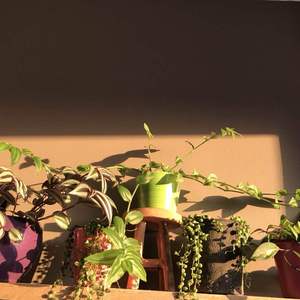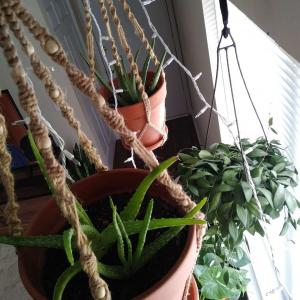求助
Pommy Mommy
2018年06月11日

I THOUGHT planted "Dwarf Sunflowers" seeds in both pots, at the same time a few weeks ago but as you can obviously see, they're two completely different looking plants. I KNOW (for sure) the brown, octagon shaped pot is sunflowers. But I have NO IDEA what the seedlings are in the round terracotta pot. P] 00P]
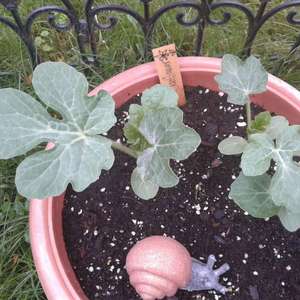
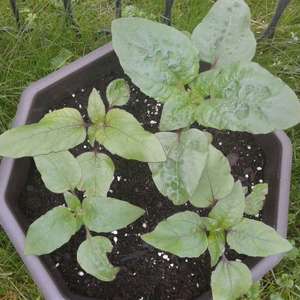


1
0
Pommy Mommy:I think you're right! I think they are Crimson watermelons and they are huge now no fruit yet but I'll post them soon as I find any
sunnyzou:most like a kind of melon
文章
Miss Chen
2018年06月04日

Description: This herbaceous perennial plant is about 1-2' tall. In mature plants, the central stem divides into 2 or 3 side stems, while immature plants usually remain undivided. The upper portion of each plant tends to nod downward because of the weight of the leaves and flowers. The terete stems are glabrous and glaucous; they are light green or pale reddish green. The alternate leaves are up to 6" long and 2" across. They are oblong-ovate to elliptic, smooth along their margins, and parallel-veined. The base of each leaf is perfoliate – it completely surrounds the stem. The upper surface of each leaf is pale green to green and glabrous, while the lower surface is white to greenish white and finely short-pubescent (canescent). In mature plants, each side stem terminates with a single flower that has an elongated bell-like shape.
The flowers are about 1-2" long and they hang downward from slender pedicels about 1" long. The pedicels are similar to the stems, except they are more slender. Each flower consists of 6 pale yellow to yellow tepals, 6 stamens, and a pistil with a tripartite style. The slender tepals are slightly twisted and greenish toward the base of the flower, while their interior surface is smooth and hairless. The yellow anthers of the stamens are large and elongated, but they remain mostly hidden by the tepals. The blooming period occurs during the mid-spring and lasts about 2 weeks. The flowers are slightly fragrant. Each flower is replaced by a 3-celled seed capsule that is obovoid in shape with 3 rounded lobes and a rounded tip; each cell of this capsule contains several seeds. The root system is rhizomatous, from which vegetative offsets are often produced. This plant occasionally forms colonies.

Cultivation: The preference is dappled sunlight during the spring and light shade during the summer. The soil should be moderately moist and loamy with a layer of decaying leaves. It is best to locate this plant underneath a deciduous tree that does not cast heavy shade during the summer. It is easier to start new plants from divisions, rather than by seeds.
Range & Habitat: The native Large-Flowered Bellwort occurs occasionally in most areas of Illinois, except for a few counties in southern part of the state (see Distribution Map). Populations of this wildflower have declined somewhat because of deer-browsing, habitat destruction, invasion of various non-native shrubs, and invasion of Garlic Mustard (Alliaria petiolata). Habitats include mesic deciduous woodlands, wooded slopes, large river banks in wooded areas, and edges of shady seeps. The presence of this plant in a deciduous woodlands is an indication that much of the original ground flora is still intact.

Faunal Associations: Bumblebees, mason bees (Osmia spp.), Halictid bees (Halictus spp., Lasioglossum spp.), and Andrenid bees (Andrena spp.) suck nectar or collect pollen from the flowers. The seeds are distributed by ants because of their attached elaiosomes (small food bodies). The foliage is heavily grazed by deer; this species declines in abundance when there is an overpopulation of deer in wooded areas. The foliage is probably vulnerable to other mammalian herbivores as well.
Photographic Location: A deciduous woodland along a river bank at Allerton Park in Piatt County, Illinois.

Comments: The flowers are rather shy and often hide behind the leaves. The foliage of Large-Flowered Bellwort (Uvularia grandiflora) is attractive and resembles the foliage of Polygonatum commutatum (Smooth Solomon's Seal). However, the leaves of the latter species are sessile or clasping, while the leaves of Large-Flowered Bellwort are perfoliate. The only other species in this genus that occurs in Illinois (the southern part only) is Uvularia sessilifolia (Sessile-Leaved Bellwort). As the name suggests, the leaves of this species are sessile, rather than perfoliate, and its flowers are a little smaller than those of Large-Flowered Bellwort. The 3-celled seed capsules of this species are sharply lobed (even winged), while the corresponding lobes of Large-Flowered Bellwort are well-rounded. Another species in this genus, Uvularia perfoliata (Perfoliate Bellwort), occurs in areas to the east of Illinois. This species has perfoliate leaves like Large-Flowered Bellwort. However, its seed capsules are truncated at their tips and its tepals have glandular hairs on the interior surface. Large-Flowered Bellwort has seed capsules with rounded tips and its tepals are smooth on the interior surface.
The flowers are about 1-2" long and they hang downward from slender pedicels about 1" long. The pedicels are similar to the stems, except they are more slender. Each flower consists of 6 pale yellow to yellow tepals, 6 stamens, and a pistil with a tripartite style. The slender tepals are slightly twisted and greenish toward the base of the flower, while their interior surface is smooth and hairless. The yellow anthers of the stamens are large and elongated, but they remain mostly hidden by the tepals. The blooming period occurs during the mid-spring and lasts about 2 weeks. The flowers are slightly fragrant. Each flower is replaced by a 3-celled seed capsule that is obovoid in shape with 3 rounded lobes and a rounded tip; each cell of this capsule contains several seeds. The root system is rhizomatous, from which vegetative offsets are often produced. This plant occasionally forms colonies.

Cultivation: The preference is dappled sunlight during the spring and light shade during the summer. The soil should be moderately moist and loamy with a layer of decaying leaves. It is best to locate this plant underneath a deciduous tree that does not cast heavy shade during the summer. It is easier to start new plants from divisions, rather than by seeds.
Range & Habitat: The native Large-Flowered Bellwort occurs occasionally in most areas of Illinois, except for a few counties in southern part of the state (see Distribution Map). Populations of this wildflower have declined somewhat because of deer-browsing, habitat destruction, invasion of various non-native shrubs, and invasion of Garlic Mustard (Alliaria petiolata). Habitats include mesic deciduous woodlands, wooded slopes, large river banks in wooded areas, and edges of shady seeps. The presence of this plant in a deciduous woodlands is an indication that much of the original ground flora is still intact.

Faunal Associations: Bumblebees, mason bees (Osmia spp.), Halictid bees (Halictus spp., Lasioglossum spp.), and Andrenid bees (Andrena spp.) suck nectar or collect pollen from the flowers. The seeds are distributed by ants because of their attached elaiosomes (small food bodies). The foliage is heavily grazed by deer; this species declines in abundance when there is an overpopulation of deer in wooded areas. The foliage is probably vulnerable to other mammalian herbivores as well.
Photographic Location: A deciduous woodland along a river bank at Allerton Park in Piatt County, Illinois.

Comments: The flowers are rather shy and often hide behind the leaves. The foliage of Large-Flowered Bellwort (Uvularia grandiflora) is attractive and resembles the foliage of Polygonatum commutatum (Smooth Solomon's Seal). However, the leaves of the latter species are sessile or clasping, while the leaves of Large-Flowered Bellwort are perfoliate. The only other species in this genus that occurs in Illinois (the southern part only) is Uvularia sessilifolia (Sessile-Leaved Bellwort). As the name suggests, the leaves of this species are sessile, rather than perfoliate, and its flowers are a little smaller than those of Large-Flowered Bellwort. The 3-celled seed capsules of this species are sharply lobed (even winged), while the corresponding lobes of Large-Flowered Bellwort are well-rounded. Another species in this genus, Uvularia perfoliata (Perfoliate Bellwort), occurs in areas to the east of Illinois. This species has perfoliate leaves like Large-Flowered Bellwort. However, its seed capsules are truncated at their tips and its tepals have glandular hairs on the interior surface. Large-Flowered Bellwort has seed capsules with rounded tips and its tepals are smooth on the interior surface.
0
0
成长记
kensong
2018年05月30日

Stem propogation of my Coleus which has grown too tall. Hopefully I'll have four new plants.
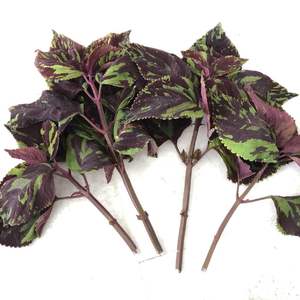
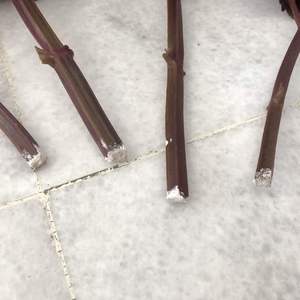
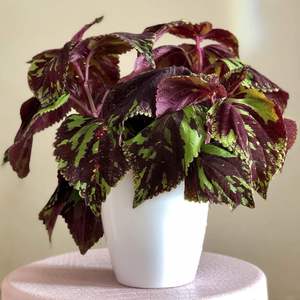



0
0
文章
Miss Chen
2018年05月27日

Description: This herbaceous perennial plant is 1½-3' tall and sparingly branched. The central stem is medium green, terete, and glabrous to slightly hairy, becoming somewhat broader where the bases of leaves wrap around it. On some plants, the central stem has a tendency to zigzag slightly between the alternate leaves. These leaves are up to 12" long, 2" across, and linear-lanceolate or elliptic-lanceolate in shape; they are smooth (entire) and sometimes slightly ciliate along their margins. Because of their length, the leaves have a tendency to arch downward from their bases. The upper leaf surface is dark green and glabrous to short-hairy, while the lower leaf surface is medium green and glabrous to short-pubescent (sometimes there are only minute hairs along the undersides of the veins). Leaf venation is parallel.
Sometimes secondary stems and leaves develop from the axils of the primary leaves. The central stem terminates in a floppy umbel of flowers on slender pedicels. Sometimes umbels of flowers are produced from the axils of the upper leaves or on short secondary stalks. Each flower is about 1" across when it is fully open, consisting of 3 light violet petals (rarely white), 3 medium green sepals, 6 stamens with yellow anthers, and a pistil with a single style. The petals are oval or broadly ovate, while the smaller sepals are ovate and usually hairy. The filaments of the stamens are pale violet; they are densely covered with spidery hairs. The pedicels of the flowers are about ½" long, medium green or reddish purple, and glabrous to hairy. At the base of each umbel of flowers, there is a leafy bract that is opposite from the alternate leaf; this bract is somewhat smaller in size.

The blooming period occurs during the summer, lasting about 1½ months. The flowers are diurnal, opening up during the morning and closing at about noon (although they may remain open longer on cloudy days). Each flower lasts only a single day. Because only a few flowers are in bloom at the same time, the blooming period is fairly long. Afterwards, the flowers are replaced by 3-chambered seed capsules (up to ¼" long); each of these capsules contain several seeds. The seeds are 2-3 mm. long and flattened-ovoid in shape; they have slightly indented centers, from which several fine grooves radiate outward in all directions toward their outer margins. The root system consists of a mass of fleshy fibrous roots, from which clonal offsets are occasionally produced.
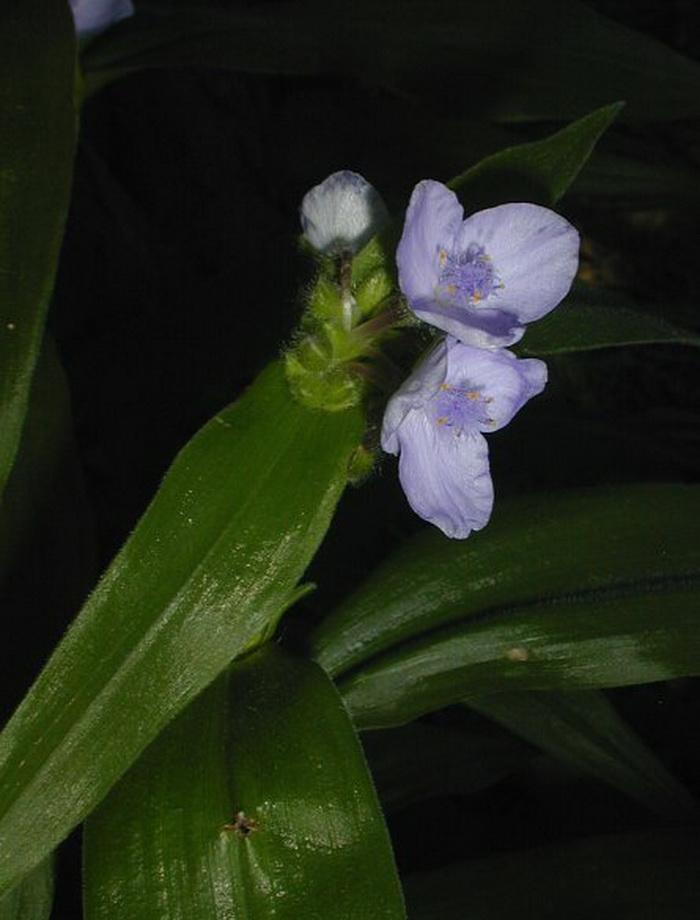
Cultivation: The preference is partial sun to medium shade, moist to mesic conditions, and a fertile loamy soil with decaying organic matter. Like other spiderworts (Tradescantia spp.), this plant is little bothered by insect pests and foliar disease. It adapts well to flower gardens in areas where there is some shade.
Range & Habitat: The native Zigzag Spiderwort occurs occasionally in the southern half of Illinois, while it is rare or absent in the northern half of the state (see Distribution Map). Habitats include rich deciduous woodlands, woodland borders, bases of bluffs, bottoms of large ravines, and shaded areas along streams. Sometimes this plant can be found in more disturbed areas, such as shaded areas along railroads, roads, and corners of yards when they are adjacent to woodlands.

Faunal Associations: The flowers are cross-pollinated by bumblebees primarily. Halictid bees, including green metallic bees, collect pollen from the flowers, while Syrphid flies feed on pollen. Insects that feed destructively on Zigzag Spiderwort include the leaf beetles Paratriarius dorsatus, Oulema collaris, and other Oulema spp.; the stink bugs Acrosternum hilaris, Mormidea lugens, Proxys punctulatus, and Euschistus spp.; and the thrips Frankliniella fusca. The mucilaginous foliage of spiderworts (Tradescantia spp.) is eaten occasionally by the Woodland Box Turtle, Cottontail Rabbit, and White-tailed Deer.
Photographic Location: Underneath the shade of a tree in a flower garden at Urbana, Illinois.
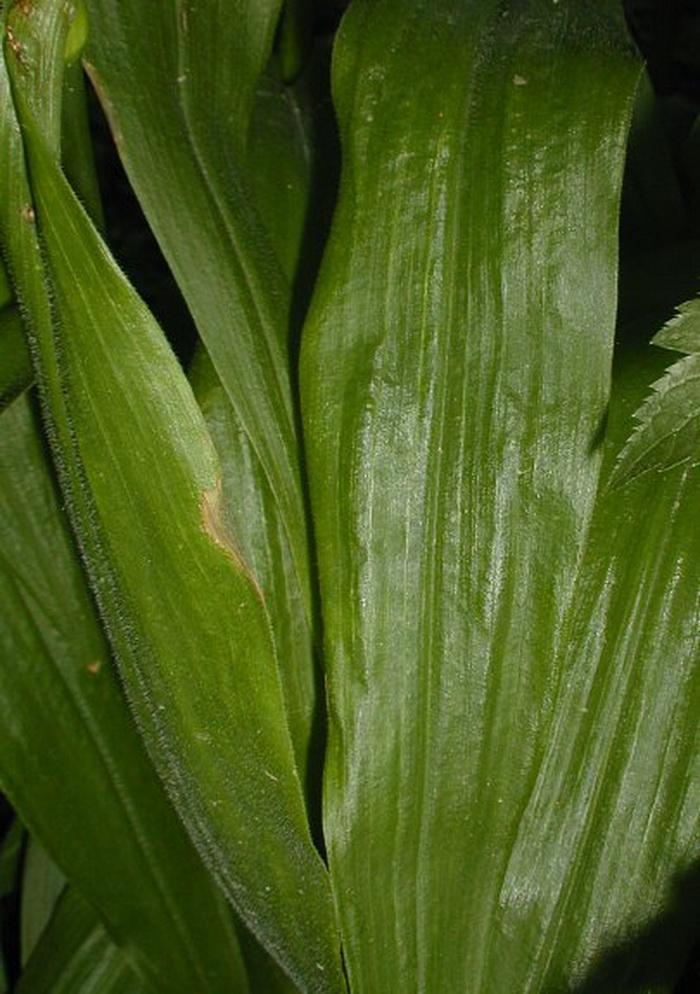
Comments: Of the several spiderwort species (Tradescantia spp.) in Illinois, Zigzag Spiderwort has the broadest leaves (up to 2" across) and they are typically dark green. Other spiderworts within the state have leaves ¾" across or less. Zigzag Spiderwort is better adapted to shady woodland areas than these other species. Another woodland species, Commelina virginica (Virginia Dayflower), has similar leaves, but the petals of its flowers are blue, rather than light violet, and its lower petal is noticeably smaller in size than the upper two. In contrast, the petals of Spiderworts are the same size. Like plant species in the Lily (Liliaceae) and Iris (Iridaceae) families, both spiderworts and dayflowers (Commelina spp.) are monocots, rather than dicots.
Sometimes secondary stems and leaves develop from the axils of the primary leaves. The central stem terminates in a floppy umbel of flowers on slender pedicels. Sometimes umbels of flowers are produced from the axils of the upper leaves or on short secondary stalks. Each flower is about 1" across when it is fully open, consisting of 3 light violet petals (rarely white), 3 medium green sepals, 6 stamens with yellow anthers, and a pistil with a single style. The petals are oval or broadly ovate, while the smaller sepals are ovate and usually hairy. The filaments of the stamens are pale violet; they are densely covered with spidery hairs. The pedicels of the flowers are about ½" long, medium green or reddish purple, and glabrous to hairy. At the base of each umbel of flowers, there is a leafy bract that is opposite from the alternate leaf; this bract is somewhat smaller in size.

The blooming period occurs during the summer, lasting about 1½ months. The flowers are diurnal, opening up during the morning and closing at about noon (although they may remain open longer on cloudy days). Each flower lasts only a single day. Because only a few flowers are in bloom at the same time, the blooming period is fairly long. Afterwards, the flowers are replaced by 3-chambered seed capsules (up to ¼" long); each of these capsules contain several seeds. The seeds are 2-3 mm. long and flattened-ovoid in shape; they have slightly indented centers, from which several fine grooves radiate outward in all directions toward their outer margins. The root system consists of a mass of fleshy fibrous roots, from which clonal offsets are occasionally produced.

Cultivation: The preference is partial sun to medium shade, moist to mesic conditions, and a fertile loamy soil with decaying organic matter. Like other spiderworts (Tradescantia spp.), this plant is little bothered by insect pests and foliar disease. It adapts well to flower gardens in areas where there is some shade.
Range & Habitat: The native Zigzag Spiderwort occurs occasionally in the southern half of Illinois, while it is rare or absent in the northern half of the state (see Distribution Map). Habitats include rich deciduous woodlands, woodland borders, bases of bluffs, bottoms of large ravines, and shaded areas along streams. Sometimes this plant can be found in more disturbed areas, such as shaded areas along railroads, roads, and corners of yards when they are adjacent to woodlands.

Faunal Associations: The flowers are cross-pollinated by bumblebees primarily. Halictid bees, including green metallic bees, collect pollen from the flowers, while Syrphid flies feed on pollen. Insects that feed destructively on Zigzag Spiderwort include the leaf beetles Paratriarius dorsatus, Oulema collaris, and other Oulema spp.; the stink bugs Acrosternum hilaris, Mormidea lugens, Proxys punctulatus, and Euschistus spp.; and the thrips Frankliniella fusca. The mucilaginous foliage of spiderworts (Tradescantia spp.) is eaten occasionally by the Woodland Box Turtle, Cottontail Rabbit, and White-tailed Deer.
Photographic Location: Underneath the shade of a tree in a flower garden at Urbana, Illinois.

Comments: Of the several spiderwort species (Tradescantia spp.) in Illinois, Zigzag Spiderwort has the broadest leaves (up to 2" across) and they are typically dark green. Other spiderworts within the state have leaves ¾" across or less. Zigzag Spiderwort is better adapted to shady woodland areas than these other species. Another woodland species, Commelina virginica (Virginia Dayflower), has similar leaves, but the petals of its flowers are blue, rather than light violet, and its lower petal is noticeably smaller in size than the upper two. In contrast, the petals of Spiderworts are the same size. Like plant species in the Lily (Liliaceae) and Iris (Iridaceae) families, both spiderworts and dayflowers (Commelina spp.) are monocots, rather than dicots.
0
0
文章
Miss Chen
2018年05月25日

Spike of FlowersDescription: This perennial wildflower is 3-12" tall, consisting of an unbranched flowering stalk, 1-2 basal leaves, and a few alternate leaves. Usually, individual plants are less than 7" tall. The basal leaves are 1-6" long and ¼-¾" across; they are lanceolate, oblanceolate, or elliptic in shape, while their margins are smooth. The alternate leaves are located along the lower half of the flowering stalk; they are often bladeless and sheath-like, but sometimes there are blades ¾-2½" long and about ¼" across. When alternate blades are present, they are narrowly lanceolate, oblanceolate, or elliptic, and their margins are smooth. Both basal and alternate leaves are medium to dark green and glabrous. The erect central stalk is medium to dark green, terete, and relatively narrow; it is glabrous below, becoming short-pubescent and glandular above. This stalk terminates in a spike of flowers about ¾-4" long. The flowers of each spike are densely arranged into 3-ranks (a double spiral). Each flower has 6 white tepals, a green ovary, and other reproductive organs. The tepals form a tubular corolla about 4-5 mm. long that is slightly curved and nodding. The corolla has an upper hood consisting of 3 fused tepals, a lower lip consisting of a single tepal, and 2 lateral tepals. As each flower develops, the lateral tepals become free toward the base and extend along the sides of the corolla. The lower lip extends to about the same length, or slightly beyond the hood. This lip is somewhat recurved, narrowly oval in shape, and its margins are slightly undulate and crisped. At the base of the lip, there is a pair of slender curved callosities (resembling minute claw-like extensions). The interior of the corolla is usually white, otherwise it is pale cream. The ovary is medium green, ovoid-oblongoid in shape, usually short-pubescent, and about 4-5 mm. long (although it becomes larger after the blooming period). Partially obscuring the ovary, there is a green bract (about 5-8 mm. in length) that is lanceolate-elliptic, short-pubescent, and glandular. The blooming period occurs during the early fall, sometimes extending into mid-fall. The flowers bloom from the bottom to the top of the raceme. Afterwards, the seed capsules develop, becoming about the same length as the bracts; they are sessile and ovoid-oblongoid in shape. Eventually, these capsules release numerous minute seeds that are carried aloft by air currents. The root system consists of a few roots that are fleshy and fibrous.
Cultivation: The preference is dappled sunlight to light shade, moist to mesic conditions that are well-drained, and soil containing loam or clay-loam with some decaying organic matter. In addition to these requirements, appropriate strains of a fungus or fungi should be present in the soil that can form a symbiotic association with the root system.

Range & Habitat: The native Lesser Ladies' Tresses has been found mostly in southern and central Illinois, where it is uncommon (see Distribution Map). However, this species appears to be slowly spreading into other parts of the state. Habitats include moist to mesic woodlands, rocky upland woodlands, open woodlands, areas along paths in woodlands, edges of swamps, and semi-shaded areas along abandoned fields. Lesser Ladies' Tresses appears to flourish when disturbance reduces competition from shrubs, trees, and tall vegetation. Such disturbance may be related to fire, wind storms, or human actions. In the wooded habitats where this wildflower occurs, the dominant trees are deciduous.
Faunal Associations: Various kinds of bees visit the flowers of Spiranthes spp. (Ladies' Tresses Orchids) for nectar, including bumblebees, Halictid bees, leaf-cutter bees (Megachile spp.), and little carpenter bees (Ceratina spp.). The foliage and flowers are browsed occasionally by mammalian herbivores, including the White-Tailed Deer, Cottontail Rabbit, and Groundhog. Because of its small size and inconspicuous nature, Lesser Ladies' Tresses can be overlooked by these herbivores, however.
Photographic Location: In a wooded area of a park in Champaign County, Illinois.
Comments: There are two varieties of Lesser Ladies' Tresses. The typical variety requires cross-pollination by insects to produce fertile seeds; it is found in several southern states. The other variety, Spiranthes ovalis erostella, has a more northern distribution that includes Illinois. This latter variety lacks some of the reproductive structures (specifically, the rostellum and viscidium) that prevent self-pollination. Therefore, in the absence of cross-pollination by insects, this variety of Lesser Ladies' Tresses is capable of self-pollination, increasing the likelihood that seeds will be produced. Lesser Ladies' Tresses can be distinguished from other Spiranthes spp. (Lady Tresses' Orchids) by its small size (typically 3-6" tall), small flowers (tepals less than 6 mm. long), and narrow flowering stalks. In particular, the base of the lower lip of each flower has a pair of slender curved callosities (resembling minute claw-like extensions) that are distinct for this species. In contrast, the callosities of a more common species, Spiranthes cernua (Nodding Ladies' Tresses), resemble a pair of wart-like protuberances at the base of the lower lip of each flower. This distinction usually requires a 10x hand lens to see.
Cultivation: The preference is dappled sunlight to light shade, moist to mesic conditions that are well-drained, and soil containing loam or clay-loam with some decaying organic matter. In addition to these requirements, appropriate strains of a fungus or fungi should be present in the soil that can form a symbiotic association with the root system.

Range & Habitat: The native Lesser Ladies' Tresses has been found mostly in southern and central Illinois, where it is uncommon (see Distribution Map). However, this species appears to be slowly spreading into other parts of the state. Habitats include moist to mesic woodlands, rocky upland woodlands, open woodlands, areas along paths in woodlands, edges of swamps, and semi-shaded areas along abandoned fields. Lesser Ladies' Tresses appears to flourish when disturbance reduces competition from shrubs, trees, and tall vegetation. Such disturbance may be related to fire, wind storms, or human actions. In the wooded habitats where this wildflower occurs, the dominant trees are deciduous.
Faunal Associations: Various kinds of bees visit the flowers of Spiranthes spp. (Ladies' Tresses Orchids) for nectar, including bumblebees, Halictid bees, leaf-cutter bees (Megachile spp.), and little carpenter bees (Ceratina spp.). The foliage and flowers are browsed occasionally by mammalian herbivores, including the White-Tailed Deer, Cottontail Rabbit, and Groundhog. Because of its small size and inconspicuous nature, Lesser Ladies' Tresses can be overlooked by these herbivores, however.
Photographic Location: In a wooded area of a park in Champaign County, Illinois.
Comments: There are two varieties of Lesser Ladies' Tresses. The typical variety requires cross-pollination by insects to produce fertile seeds; it is found in several southern states. The other variety, Spiranthes ovalis erostella, has a more northern distribution that includes Illinois. This latter variety lacks some of the reproductive structures (specifically, the rostellum and viscidium) that prevent self-pollination. Therefore, in the absence of cross-pollination by insects, this variety of Lesser Ladies' Tresses is capable of self-pollination, increasing the likelihood that seeds will be produced. Lesser Ladies' Tresses can be distinguished from other Spiranthes spp. (Lady Tresses' Orchids) by its small size (typically 3-6" tall), small flowers (tepals less than 6 mm. long), and narrow flowering stalks. In particular, the base of the lower lip of each flower has a pair of slender curved callosities (resembling minute claw-like extensions) that are distinct for this species. In contrast, the callosities of a more common species, Spiranthes cernua (Nodding Ladies' Tresses), resemble a pair of wart-like protuberances at the base of the lower lip of each flower. This distinction usually requires a 10x hand lens to see.
0
0
Stefanie050674
2018年05月22日

my plants around the yard are beginning to get some growth under their belts. the yard will be so pretty in a month or two. by my 4th of July, it'll be AWESOME! THE 💣!!
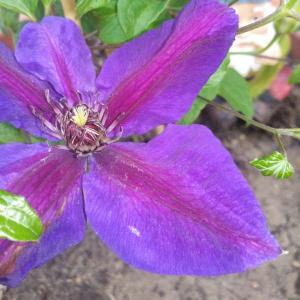

0
0
文章
Miss Chen
2018年05月21日

Description: This herbaceous perennial plant is 1–1½' tall. Infertile plants are unbranched, producing a single leaf from a long stalk, while fertile plants produce a pair of leaves on long petioles at the apex of this stalk. The stalks are light green to pale reddish green, glabrous, and terete (circular in circumference). The leaves of infertile plants are up to 1' long and 1' across; they are orbicular in outline, fully peltate, and deeply divided in 6-9 palmate lobes. The leaves of fertile plants are similar, although they are less orbicular in outline, only marginally peltate, and they tend to have fewer lobes (typically 5-6). The leaves of both infertile and fertile plants have lobes that are obovate in shape. The outer margins of these lobes are coarsely dentate and often shallowly cleft; less typically, they are coarsely crenate, slightly undulate, or smooth (entire). The upper leaf surface is medium to dark green and glabrous. On fertile plants, the ascending petioles of the leaves are 3-6" long, light green to pale reddish green, glabrous, and terete. The petioles join the leaf blades toward the inner margins of the latter. Each fertile plant produces a single nodding flower where the 2 petioles branch from each other.
This flower is about 1½" across, consisting of 6-9 white petals, 6 light green sepals, 12-18 stamens, and a superior ovary with a dome-shaped cluster of stigmata at its apex. Both the petals and sepals are oval-obovate in shape; the latter are glabrous and early-deciduous. The ovary is ovoid in shape and light green to pale yellow. The stamens have white filaments and yellow anthers. The pedicel of the flower is about 1½" long, light green to yellowish green, and glabrous. The blooming period occurs from mid- to late spring, lasting about 2-3 weeks. Individual flowers are short-lived; they have a pleasant fragrance. Each flower is replaced by an ovoid berry that is fleshy and contains several seeds. At maturity, this berry is about 1½" long and pale yellow. A berry is produced only when cross-pollination of the flower occurs. The root system is long-rhizomatous and fibrous. Mayapple often produces dense colonial colonies that exclude other spring-flowering plants.
Cultivation: The preference is dappled sunlight to light shade, moist to slightly dry conditions, and a rich loamy soil with abundant organic matter. This plant is easy to start from rhizomes and it will readily adapt to garden areas near deciduous trees. It is a strong colonizer and may spread aggressively in some situations. Young foliage is vulnerable to late-frost damage. The mature foliage dies down by the end of summer.

Range & Habitat: The native Mayapple is a common plant that occurs in every county of Illinois (see Distribution Map). It is found primarily in mesic deciduous woodlands, open woodlands, small woodland openings, savannas, and edges of hillside seeps in wooded areas. Mayapple occurs in high quality old-growth woodlands and also open woodlands that have some history of disturbance.
Faunal Associations: The flowers are cross-pollinated by bumblebees and other long-tongued bees. These insects collect pollen and possibly suck nectar. The larvae of a sawfly, Aglaostigma quattuordecimpunctatum, feed on the leaves of Mayapple (Smith, 2006). Adults of a thrips, Ctenothrips bridwelli, have been found on the foliage (Stannard, 1968). The foliage of Mayapple is avoided by mammalian herbivores because of its poisonous qualities and bitter taste. The seeds and rhizomes are also poisonous. The berries are edible if they are fully ripe; they are eaten by box turtles and possibly by such mammals as opossums, raccoons, and skunks. The seeds are distributed to new locations in the feces of these animals.

Photographic Location: A mesic deciduous woodland at Busey Woods in Urbana, Illinois.
Comments: Mayapple is a familiar woodland plant with interesting foliage. The flowers are large and attractive, but they are sparingly produced and mostly hidden by the large leaves. Mayapple develops very quickly during the warmer days of spring. There is no other plant within the state that resembles it; the only other species in this genus occurs in Asia. People can eat the ripe berries in limited amounts, even though they may be mildly toxic. The flavor is bland and resembles an overripe melon.
This flower is about 1½" across, consisting of 6-9 white petals, 6 light green sepals, 12-18 stamens, and a superior ovary with a dome-shaped cluster of stigmata at its apex. Both the petals and sepals are oval-obovate in shape; the latter are glabrous and early-deciduous. The ovary is ovoid in shape and light green to pale yellow. The stamens have white filaments and yellow anthers. The pedicel of the flower is about 1½" long, light green to yellowish green, and glabrous. The blooming period occurs from mid- to late spring, lasting about 2-3 weeks. Individual flowers are short-lived; they have a pleasant fragrance. Each flower is replaced by an ovoid berry that is fleshy and contains several seeds. At maturity, this berry is about 1½" long and pale yellow. A berry is produced only when cross-pollination of the flower occurs. The root system is long-rhizomatous and fibrous. Mayapple often produces dense colonial colonies that exclude other spring-flowering plants.
Cultivation: The preference is dappled sunlight to light shade, moist to slightly dry conditions, and a rich loamy soil with abundant organic matter. This plant is easy to start from rhizomes and it will readily adapt to garden areas near deciduous trees. It is a strong colonizer and may spread aggressively in some situations. Young foliage is vulnerable to late-frost damage. The mature foliage dies down by the end of summer.

Range & Habitat: The native Mayapple is a common plant that occurs in every county of Illinois (see Distribution Map). It is found primarily in mesic deciduous woodlands, open woodlands, small woodland openings, savannas, and edges of hillside seeps in wooded areas. Mayapple occurs in high quality old-growth woodlands and also open woodlands that have some history of disturbance.
Faunal Associations: The flowers are cross-pollinated by bumblebees and other long-tongued bees. These insects collect pollen and possibly suck nectar. The larvae of a sawfly, Aglaostigma quattuordecimpunctatum, feed on the leaves of Mayapple (Smith, 2006). Adults of a thrips, Ctenothrips bridwelli, have been found on the foliage (Stannard, 1968). The foliage of Mayapple is avoided by mammalian herbivores because of its poisonous qualities and bitter taste. The seeds and rhizomes are also poisonous. The berries are edible if they are fully ripe; they are eaten by box turtles and possibly by such mammals as opossums, raccoons, and skunks. The seeds are distributed to new locations in the feces of these animals.

Photographic Location: A mesic deciduous woodland at Busey Woods in Urbana, Illinois.
Comments: Mayapple is a familiar woodland plant with interesting foliage. The flowers are large and attractive, but they are sparingly produced and mostly hidden by the large leaves. Mayapple develops very quickly during the warmer days of spring. There is no other plant within the state that resembles it; the only other species in this genus occurs in Asia. People can eat the ripe berries in limited amounts, even though they may be mildly toxic. The flavor is bland and resembles an overripe melon.
0
0
文章
Miss Chen
2018年05月18日

Description: This perennial wildflower is 1-2½' tall, consisting of an erect unbranched stem and 1-2 whorls of leaves. Plants without flowers produce only a single whorl of leaves, while flowering plants produce 2 whorls of leaves. The central stem is medium green, terete, and woolly-pubescent to glabrous; it becomes more glabrous with age. In a flowering plant, the lower whorl of leaves occurs near the middle of the central stem; this whorl has 5-10 leaves that are 2½-5" long and ½-2" across. The upper whorl of leaves occurs underneath the inflorescence; this whorl has 3-5 leaves that are 2-4" long and ½-2" across. All of these leaves are elliptic to ovate in shape, smooth along their margins, and sessile. The upper leaf surface is medium green and glabrous, while the lower surface is pale green. Individual leaves have 3-5 parallel primary veins and a fine network of secondary veins.
The inflorescence consists of a sessile umbel of 3-9 flowers on pedicels about 1" long. These flowers are held either a little above or below the leaves when they are in bloom. Individual flowers are about 2/3" (16 mm.) across, consisting of 6 yellowish green tepals, 6 stamens, a 3-celled ovary, and 3 reddish purple to brown stigmata. The tepals are lanceolate in shape and recurved. The stigmata are large in size and recurved, spanning the width of each flower. The pedicels are light green and glabrous. The blooming period occurs from late spring to early summer, lasting about 1 month. Afterwards, the pedicels become more erect, holding the developing berries above the upper whorl of leaves. At maturity, these berries are dark purple, globoid, and about 1/4" to 1/3" (6-8 mm.) across. Each berry contains several seeds. The root system consists of a thick rhizome with fibrous roots. Small colonies of plants can develop from the rhizomes.
Cultivation: The preference is dappled sunlight to medium shade, moist to mesic conditions, and soil containing loam or sandy loam with decaying organic matter.

Range & Habitat: The native Indian Cucumber-Root is located in two counties of NE Illinois, where it is rare and state-listed as 'endangered' (see Distribution Map). Illinois lies along the western range-limit of this species. Habitats consist of rich mesic woodlands, edges of swamps, forested bogs, and at the bases of wooded dunes. In mesic areas, this wildflower is typically located in beech-maple woodlands, while in more swampy areas it is found near Red Maple, Black Ash, and other deciduous trees that prefer moist areas.
Faunal Associations: Very little is known about floral-faunal relationships for this species. Sometimes, such small rodents as the White-Footed Mouse and Woodland Deer Mouse eat the seeds and berries (Hamilton, 1941).

Photographic Location: The base of a wooded sand dune near the edge of a swamp at the Indiana Dunes National Lakeshore in NW Indiana.
Comments: The common name refers to the flavor of the rhizome, which is said to resemble the flavor of cucumbers. Because of the oversized stigmata, the flowers of Indian Cucumber-Root have an odd appearance. Non-flowering plants with a single whorl of leaves superficially resemble an orchid, Isotria verticillata (Large Whorled Pogonia). However, this orchid has been found only in southern Illinois, where Indian Cucumber-Root does not occur. In areas where their ranges overlap outside of the state, these two species can be distinguished by the differing patterns of their secondary veins.
The inflorescence consists of a sessile umbel of 3-9 flowers on pedicels about 1" long. These flowers are held either a little above or below the leaves when they are in bloom. Individual flowers are about 2/3" (16 mm.) across, consisting of 6 yellowish green tepals, 6 stamens, a 3-celled ovary, and 3 reddish purple to brown stigmata. The tepals are lanceolate in shape and recurved. The stigmata are large in size and recurved, spanning the width of each flower. The pedicels are light green and glabrous. The blooming period occurs from late spring to early summer, lasting about 1 month. Afterwards, the pedicels become more erect, holding the developing berries above the upper whorl of leaves. At maturity, these berries are dark purple, globoid, and about 1/4" to 1/3" (6-8 mm.) across. Each berry contains several seeds. The root system consists of a thick rhizome with fibrous roots. Small colonies of plants can develop from the rhizomes.
Cultivation: The preference is dappled sunlight to medium shade, moist to mesic conditions, and soil containing loam or sandy loam with decaying organic matter.

Range & Habitat: The native Indian Cucumber-Root is located in two counties of NE Illinois, where it is rare and state-listed as 'endangered' (see Distribution Map). Illinois lies along the western range-limit of this species. Habitats consist of rich mesic woodlands, edges of swamps, forested bogs, and at the bases of wooded dunes. In mesic areas, this wildflower is typically located in beech-maple woodlands, while in more swampy areas it is found near Red Maple, Black Ash, and other deciduous trees that prefer moist areas.
Faunal Associations: Very little is known about floral-faunal relationships for this species. Sometimes, such small rodents as the White-Footed Mouse and Woodland Deer Mouse eat the seeds and berries (Hamilton, 1941).

Photographic Location: The base of a wooded sand dune near the edge of a swamp at the Indiana Dunes National Lakeshore in NW Indiana.
Comments: The common name refers to the flavor of the rhizome, which is said to resemble the flavor of cucumbers. Because of the oversized stigmata, the flowers of Indian Cucumber-Root have an odd appearance. Non-flowering plants with a single whorl of leaves superficially resemble an orchid, Isotria verticillata (Large Whorled Pogonia). However, this orchid has been found only in southern Illinois, where Indian Cucumber-Root does not occur. In areas where their ranges overlap outside of the state, these two species can be distinguished by the differing patterns of their secondary veins.
0
0
成长记
💫sammie💫
2018年05月17日

been having the tray for about a week, a relative offered to give me a few leaves since they saw i've taken interest in plants! some are from my sunsets, two of its leaves are growing some teeny-tiny roots! the other two, i'm not sure of their type, but they're growing well!








0
0
文章
Miss Chen
2018年05月15日

A summer squash, the zucchini grows well in most summer vegetable gardens. You only need one zucchini plant to produce fruit, as the plants grow separate male and female flowers on the same plant, which are usually pollinated by bees and other insects. You can also pollinate the flowers by hand if you are growing them in a greenhouse or other area where insect pollination isn't possible. Telling the difference between the male and female blooms ensures you pollinate the zucchini correctly for the maximum amount of fruit at harvest time.

Step 1
Inspect the stems of the flowers. Female flowers have short stems while male flowers have long, thin stems.
Step 2
Look behind the flower for a swollen base. Flowers with the swollen base are female, as this is the ovary that later develops into the zucchini after germination.

Step 3
Find the stamen in the center of suspected male blossoms. Male flowers have a single, long stamen that is covered in pollen, while female blossoms have a stigma with multiple stems inside.

Step 1
Inspect the stems of the flowers. Female flowers have short stems while male flowers have long, thin stems.
Step 2
Look behind the flower for a swollen base. Flowers with the swollen base are female, as this is the ovary that later develops into the zucchini after germination.

Step 3
Find the stamen in the center of suspected male blossoms. Male flowers have a single, long stamen that is covered in pollen, while female blossoms have a stigma with multiple stems inside.
0
0



